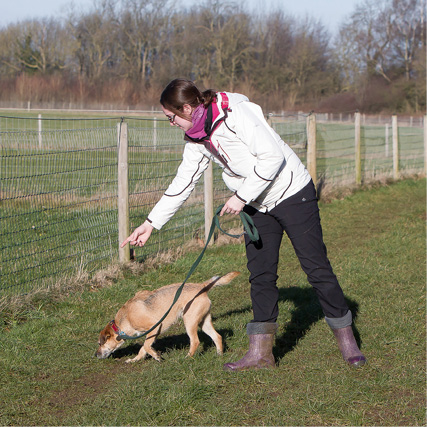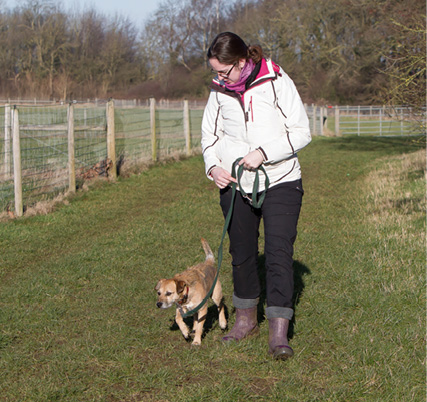Appendix 1 – Loose lead walking with ‘sniff’ cue
It is much more pleasant to walk your dog on-lead if he doesn’t pull, and walking on a loose lead is more comfortable for him, too. However, it can take a while for him to master the skill of walking at our pace and dividing his attention between the world he finds fascinating – especially its scents – and the human at the other end of the lead.
There are many different ways to teach dogs to walk nicely on a lead, and, as long as the technique you choose is not detrimental to your dog’s welfare, it’s up to you to determine the method that best suits you both. Regardless of the techniques you’ve used before, if you are struggling, it’s worth starting afresh – try swapping the side that your dog walks on initially to make it new for him – and be sure to be consistent in your approach.
During your period of training, there will be times when you and your dog just need to get from A to B, and you don’t have the time or the patience to be consistent with loose lead walking, so a different harness or collar is a good way of differentiating this for your dog. Choose the collar or harness you want to use when you are training your dog on a loose lead, and use a different type for times when the rules will not be in play.
The following is a suggestion for a training technique which we find works well. The aim is to enable your dog to walk with you without pulling, whilst still enjoying the walk and the environment around him. Of course, you should both enjoy the walk, as we regard loose lead walking as a partnership between person and dog: a contract in which your dog’s undertaking is not to pull and not to trip you up, and yours is to allow your dog to enjoy the walk by doing things he enjoys – for example, sniffing bushes, investigating holes, and greeting people and dogs where appropriate. This technique is not intended to teach obedience heelwork.
• Begin with an appropriately fitting flat collar, harness or head halter attached to a lead which is long enough to allow your dog to walk comfortably alongside you with slack in the lead between your hand and him.
• Decide on which side you would like your dog to walk.
• Arm yourself with tasty, easily swallowed treats – cheese, chicken, hot dog – that are cut up very small, and adjust his daily ration accordingly.
• Find a quiet, distraction-free, safe environment in which to work. It is ideal to start in your living room or garden at first, and not after he has just been fed.
• Attach the lead to your dog’s collar or harness and stand still.
• Say nothing, and as soon as he pays you any attention, tell him he’s good and feed him a treat.
• Now use a treat in your fingers to bring him into position at your side.
• Make sure the lead is loose and that there is no pressure on his collar/harness: the lead is simply a safety line, not a means of directing his movement.
• Feed him treats simply for standing next to you. He is learning that being at your side is a good place to be.
• Take one step forward and, as he moves with you, feed a treat into his mouth. Try to feed him for staying alongside you; don’t wait for him to get ahead. If he is reluctant to move as you step forward, use another treat to entice him into position next to you again.
• If he moves along keeping pace with you, feed him a couple more treats as you slowly take a few steps forward.
• After practising this for a few days, walk a little further before feeding a treat, so that it isn’t quite as easy for him.
• If, at any time, he gets ahead of you or becomes distracted and pulls sideways or backwards, stand still immediately, don’t say anything, and wait for his attention to return to you. Once you have this, use a treat in your fingers, or a hand gesture, to return him to your side, and have him walk a couple of steps next to you before receiving a treat.
Remember, he doesn’t have to be glued to your leg, just moving with you and not pulling.
Take care not to feed him a treat immediately after he comes back to you as this can very quickly teach him that the quickest way to get a treat is to pull away and then return.
• Repeat this initial training in different places, with gradually increasing distractions. Practise until he can walk alongside you for about 20 paces without pulling before receiving a treat, and if he does pull, can return to position to be able to move forward without requiring a hand signal to prompt him: ie he can work out what he needs to do to move forward again.
• At this point, for most dogs, moving forward becomes a more important reward than the food, so you can try to fade out the food rewards, unless in a very distracting place where he will need extra help to get it right.
• When you reach this stage of training, you may find that he develops the very annoying habit of yo-yo-ing on the lead; pulling and then coming back so that your walk becomes a stop/start affair. In this case, the next part of the training becomes very important.
• Next time your dog pulls and then moves back into position, DON’T continue forward. You’ll probably find that he anticipates you’re going to move and bounces forward to pull again. Stand still.
• At this point you want your dog to understand he has to be with you mentally before he can move forward. In other words, he has to be paying you real attention, and be in tune with you, to be able to move forward, not focusing totally on the environment and just flicking you an occasional look.
• Judging this mental state can be difficult, but look for signs that your dog has moved his attention from the environment and firmly back to you. Some dogs demonstrate this by sitting next to you, some show a more relaxed posture instead of being intently focused on the wider environment, some make sustained eye contact with you.
• When you see this change in behaviour, tell him he is very good and move forward again.
• It may be beneficial to use food rewards again for a while so that the change in mental attitude receives two payoffs – food and movement – but DON’T give in to the temptation to use a food treat to move him into position. At this point we want your dog to take responsibility for walking without pulling, which means that it will no longer be necessary for you to manage him or remind him as he will have learned to manage himself.
• With time he will develop the skill of paying you just enough attention to match his pace to yours and change direction with you while enjoying his surroundings. At this point he won’t be actively looking at you at all (or rarely), but will simply be keeping you in his peripheral vision.
• To easily switch him between being allowed to sniff at his own pace and move along with you without sniffing when you need him to, you need to add additional steps to your training (see images). Once he has learnt the basics, give him a specific ‘let’s go’ cue word as you start out on your walk. Keep his focus on you by talking to him, and possibly feeding him a few treats.

This dog is walking nicely at his owner’s side, and she is engaging with him to encourage him to walk next to her.

He is given permission to investigate something of interest with both a verbal “go sniff” cue and a hand signal.

His owner walks along slowly with him at his pace so that he can investigate the interesting smells as much as he likes.


When it’s time to move on, his owner encourages him to come back to her to walk forward at her pace again.